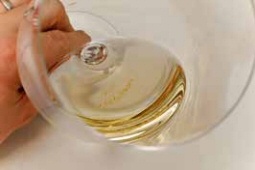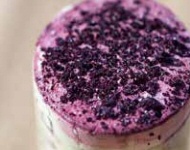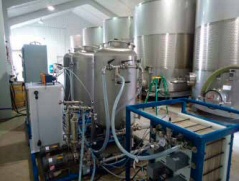
Have you ever held up a bottle of white wine and seen flakey things settled on the bottom? If so, perhaps you wondered how could a wine with flakes, which may even look like small pieces of glass, possibly be good? The same can be said for those times you’ve opened a bottle and noticed a thick layer of what appears to be little crystals on the end of the extracted cork. This undoubtedly resulted in the same situation – you seriously doubting you are about to taste a decent wine.
The irony of the situation is that the flakes and crystals in white wines do represent a flaw in the wine; however, it’s not what you think. This is only what can be perceived as an aesthetic flaw. And, in fact, the presence of these flakes or crystals may indicate a wine of superior quality, despite what may be perceived as an undesirable presentation.
What you are seeing is crystallized tartaric acid, commonly referred to as wine diamonds or Weinstein (wine stone). Acids naturally occur in many plants, including grapes, and tartaric acid is one of these acids.
This natural acid in grapes increases the longer grapes hang on the vine, which could eventually lead to more buildup of wine diamonds in a bottle. Furthermore, the more time the wine is given to ferment increases the potential presence of wine diamonds appearing in a bottle.
 As white wines generally are higher in acids than red wines, this is more of a concern for white wines. However, after a long period in the bottle, red wines may have wine diamonds form as well, although their appearance will most likely be more recognizable as traditional red wine sediment. As white wines generally are higher in acids than red wines, this is more of a concern for white wines. However, after a long period in the bottle, red wines may have wine diamonds form as well, although their appearance will most likely be more recognizable as traditional red wine sediment.
So why don’t you see flakes in white wine bottles or wine crystals underneath corks more often? The answer is called “cold stabilization.” Although it can and is sometimes used by larger commercial wineries for red wines, cold stabilization is most often used for white wines.
This is an optional part of the winemaking process where the wine is chilled for about two weeks at temperatures close to freezing before bottling. While the wine is in tanks undergoing fermentation, this process speeds up the crystallization process and as the wine diamonds form, they will settle at the bottom of the tank. When the wine is then transferred to another tank for filtration purposes, a mother lode of wine diamonds is left behind. In larger wineries, the wine diamonds are harvested and later used to make cream of tartar, which bakers know serves as a great leavening agent.
Cold stabilization is optional in the sense that it’s not a requirement to produce wine and is done solely for aesthetic purposes to make wines more attractive. However, this is primarily a new world practice, as not using cold stabilization during the process is more common in Europe.
And there are reasons to avoid cold stabilization. By subjecting wines to cold stabilization, the taste of the wine could be altered and some winemakers actually refer to the process as “tearing apart” their wines.
Yet, winemakers concerned with the appearance of their product will be inclined to use cold stabilization. But not all prescribe cold stabilization to their wines, as you’ll occasionally find brave ones such as Annette Hoff Danzer at Monterey County’s own Cima Collina winery. Annette’s Pinot Blanc, available in A Taste of Monterey’s wine arsenal, is a prime example of a wine not undergoing cold stabilization. We think you’ll agree that the result is nothing short of excellence.
The presence of wine diamonds indicates a wine with grapes which were allowed to ripen on the vine for a long time. And wine diamonds tell us that the winemaker fermented the wine slowly and with care. So instead of having a flawed wine, you actually may have a high quality wine on your hands.
 And a turn of irony is that from Europe, France in fact, a new machine has been invented which performs what is called “electrodyalisis.” This process performs the same functions as cold stabilization, with none of the potential negative impacts. However, it could be some time before these still expensive machines make it into the mainstream global wine production. And a turn of irony is that from Europe, France in fact, a new machine has been invented which performs what is called “electrodyalisis.” This process performs the same functions as cold stabilization, with none of the potential negative impacts. However, it could be some time before these still expensive machines make it into the mainstream global wine production.
For now, just know that if you see flakes or crystals in your bottle of wine, don’t be afraid. And don’t worry – there is no harm in ingesting them. Instead see them as they are... gems of the bottle…diamonds. |